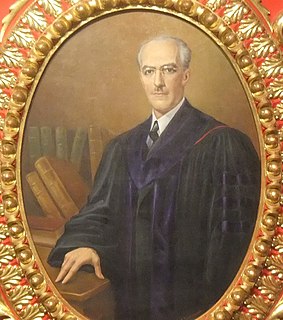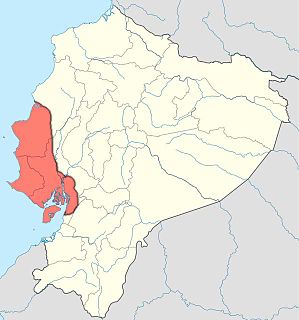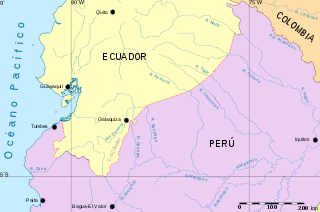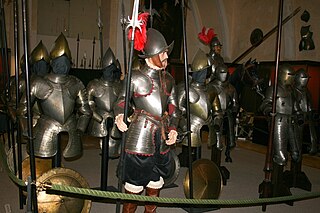 W
WMelchior Aymerich was a Spanish general and provincial administrator, serving as the last president of the Royal Audience of Quito from April until May 1822. One of the last Spanish colonial provinces to be overthrown during the final years of the Spanish American wars of independence, he was defeated by rebel General Antonio José de Sucre at the Battle of Pichincha on May 24, 1822, formally surrendering two days later.
 W
WThe Bahía culture was a pre-Columbian culture in Ecuador.
 W
WThe Battle of Pichincha took place on 24 May 1822, on the slopes of the Pichincha volcano, 3,500 meters above sea-level, right next to the city of Quito, in modern Ecuador.
 W
WSebastián de Belalcázar was a Spanish conquistador. De Belalcázar, also written as de Benalcázar, is known as the founder of important early colonial cities in the northwestern part of South America; Quito in 1534 and Cali, Pasto and Popayán in 1537. De Belalcázar led expeditions in present-day Ecuador and Colombia and died of natural causes after being sentenced to death in Cartagena, at the Caribbean coast in 1551.
 W
WThe Bolivarian countries are six Hispanic American countries whose republican origin is attributed to the ideals of Simón Bolívar and independence war led by the Venezuelan military in the viceroyalties of New Granada and Peru.
 W
WThe Cañari are an indigenous ethnic group traditionally inhabiting the territory of the modern provinces of Azuay and Cañar in Ecuador. They are descended from the independent pre-Columbian tribal confederation of the same name. The historic people are particularly noted for their resistance against the Inca Empire. Eventually conquered by the Inca in the early 16th century shortly before the arrival of the Spanish, the Cañari later allied with the Spanish against the Inca. Today, the population of the Cañari, who include many mestizos, numbers in the thousands.
 W
WThe Capulí culture refers to an archaeological classification for a group in Pre-Columbian South America on the Andean plain in what is now northern Ecuador and southern Colombia. The Capulí preceded the Piartal and Tuza cultures in the archaeological record ranging from around 800 to 1500 CE. The Capulí culture left a strong record through its pottery. The Capulí had distinctive black on dark red pottery with rectilinear geometric designs. The anthropomorphic pottery statues of the Capulí can be striking. Women are depicted with a wrap that extends from the armpit to the ankle while men have loincloths and are often shown with an object such as a drum or animal. These figures are often called coqueros because they are depicted with wads of coca leaves in their mouths. Scholars have associated the figures with shamans and possible funerary rituals.
 W
WThe Cara culture flourished in coastal Ecuador, in what is now Manabí Province, in the first millennium CE.
 W
WThe Cotocollao culture were an indigenous Pre-Columbian culture that inhabited the valley that is now the Quito area, in Ecuador.
 W
WThe Ecuadorian War of Independence was fought from 1820 to 1822 between several South American armies and Spain over control of the lands of the Royal Audience of Quito, a Spanish colonial administrative jurisdiction from which would eventually emerge the modern Republic of Ecuador. The war ended with the defeat of the Spanish forces at the Battle of Pichincha on May 24, 1822, which brought about the independence of the entire Presidencia de Quito. The Ecuadorian War of Independence is part of the Spanish American wars of independence fought during the first two decades of the 19th century.
 W
WThe Ecuadorian–Peruvian War, known locally as the War of '41, was a South American border war fought between 5–31 July 1941. It was the first of three military conflicts between Ecuador and Peru during the 20th century. During the war, Peru occupied the western Ecuadorian province of El Oro and parts of the Andean province of Loja.
 W
WThe Ecuadorian–Peruvian War took place between 1857 and 1860. The conflict began when Ecuador attempted to sell Amazon basin land claimed by Peru in order to settle a debt with British creditors. When diplomatic relations between the two countries broke down, prior to the fragmentation of the Ecuadorian government into several competing factions, the Peruvian government ordered a blockade of Ecuador's ports in order to force the cancellation of the sale, and the official acknowledgement of Peruvian ownership of the disputed territories. By late 1859, control of Ecuador was consolidated between General Guillermo Franco, in the city of Guayaquil, and a provisional government in Quito headed by Gabriel García Moreno. Peruvian President Ramón Castilla sailed to Guayaquil with several thousand soldiers in October 1859, and negotiated the Treaty of Mapasingue with General Franco in January 1860. The signing of the treaty indicated Ecuadorian compliance with all of Peru's demands, and temporarily marked the end of the territorial dispute between the two countries. However, in September 1860, the forces of the provisional government, commanded by García Moreno and General Juan José Flores defeated Franco's government at the Battle of Guayaquil, ending the civil war in Ecuador. The new government disavowed the Treaty of Mapasingue, followed shortly afterwards by its Peruvian counterpart; this re-opened the territorial dispute.
 W
WIsabel Godin des Odonais was an 18th-century woman who became separated from her husband in South America by colonial politics, and was not reunited with him until more than 20 years later. Her long journey, from western Peru to the mouth of the Amazon River, is considered unusual in the history of South America. Her story has been often repeated and inspired popular misconceptions of the dangers of the tropical rain forest.
 W
WGran Colombia is the historiographical designation for the state, then known simply as Colombia, that encompassed much of northern South America and part of southern Central America from 1819 to 1831. The state included the territories of present-day Colombia, Ecuador, Panama and Venezuela, and parts of northern Peru and northwestern Brazil. The term Gran Colombia is used historiographically to distinguish it from the current Republic of Colombia, which is also the official name of the former state.
 W
WThe history of the Republic of Ecuador from 1830 to 1860 begins with the collapse of the nation of Gran Colombia in 1830, followed by the assassination of Antonio José de Sucre and the death of Simón Bolívar from tuberculosis the same year. Heartbroken at the dissolution of Gran Colombia, Bolívar is quoted to have said shortly before his death, "America is ungovernable. Those who have served the revolution have plowed the sea." These words would seem prophetic during the chaotic first thirty years in the existence of Ecuador.
 W
WThis is a summary of the history of Ecuador from 1860–1895. Gabriel García Moreno is the father of Ecuadorian conservatism and no doubt the most controversial figure in the nation's history, condemned by Liberal historians as Ecuador's worst tyrant but exalted by Conservatives as the nation's greatest nation-builder. In the end, both appraisals may be accurate; the man who possibly saved Ecuador from disintegration in 1859 and then ruled the nation with an iron fist for the subsequent decade and a half was, in fact, an extremely complicated personality. Born and raised under modest circumstances in Guayaquil, he studied in Quito, where he married into the local aristocracy, then traveled to Europe in the aftermath of the 1848 revolutionary uprisings and studied under the eminent Catholic theologians of the day.
 W
WThis is a summary of the history of Ecuador from 1895-1925. Eloy Alfaro is the outstanding standard-bearer for Ecuador's Liberals, much as Gabriel García Moreno is for the Conservatives. Some Marxist groups have also looked to Alfaro; although his political program was in no way socialist, it did prove to be revolutionary in the extent to which it stripped the Roman Catholic Church of the power and privileges previously granted to it by García Moreno. Catholic officials and their Conservative allies did not give up without a fight, however. During the first year of Alfaro's presidency, Ecuador was ravaged by a bloody civil war in which clergymen commonly incited the faithful masses to rise in rebellion against the "atheistic alfaristas" and were, just as commonly, themselves victims of alfarista repression. The foreign-born Bishops Pedro Schumacher of Portoviejo and Arsenio Andrade of Riobamba led the early resistance to Alfaro. A fullfledged bloodbath may well have been averted only through the magnanimous efforts of the outstanding historian and Archbishop Federico González Suárez, who urged the clergy to abandon the pursuit of politics.
 W
WThis is a summary of the history of Ecuador from 1925 – 1944.
 W
WThis is a summary of the history of Ecuador from 1944–1960.
 W
W W
WThe territorial dispute between Ecuador and Peru was the source of a long period of intermittent armed conflict between the two countries. This dispute was a consequence of each country's interpretation of what Real Cedulas Spain used to precisely define its colonial territories in the Americas. After independence, all of Spain's colonial territories signed and agreed to proclaim their limits in the basis of the principle uti possidetis juris which accepts the Spanish colonial borders of 1810 as the borders of the new republics. Thus the borders of Gran Colombia which included Ecuador, Colombia and Venezuela would follow the borders of the Viceroyalty of New Granada, and Peru the Viceroyalty of Peru in 1810. However, Peru was not satisfied with this and tried to set the date of her Uti Possitedis to 1824 – a time when Peru was officially independent with territories Peru militarily occupied since 1820.
 W
WThe history of the Jews in Ecuador dates back to the 16th and 17th centuries, when Sephardic Jews began arriving from Spain and Portugal as a result of the Spanish Inquisition. Ecuadorian Jews are members of a small Jewish community in the territory of today's Ecuador, and they form one of the smallest Jewish communities in South America.
 W
WThe Inca Empire, also known as the Incan Empire and the Inka Empire, was the largest empire in pre-Columbian America. The administrative, political and military center of the empire was in the city of Cusco. The Inca civilization arose from the Peruvian highlands sometime in the early 13th century. Its last stronghold was conquered by the Spanish in 1572.
 W
WIndigenous peoples in Ecuador, also Native Ecuadorians or Native Americans, are the groups of people who were present in what became Ecuador before the Spanish colonization of the Americas. The term also includes their descendants from the time of the Spanish conquest to the present. Their history, which encompasses the last 11,000 years, reaches into the present; 25 percent of Ecuador's population is of indigenous heritage, while another 70 percent is of mixed indigenous and European heritage.
 W
WJacinto Jijón y Caamaño(December 11, 1890 – August 17, 1950) was an Ecuadorian historian, archeologist, and politician. He was the mayor of the city of Quito from 1946 to 1948. He was a member of the Ecuadorian parliament and a candidate for the presidency of Ecuador. He published several works about the pre-Hispanic history of cultures in Ecuador.
 W
WThe Machalilla were a prehistoric people in Ecuador, in southern Manabí and the Santa Elena Peninsula. The dates when the culture thrived are uncertain, but are generally agreed to encompass 1500 BCE to 1100 BCE.
 W
WThe Manteño civilization were the last pre-Columbian civilization in modern-day Ecuador, active from 850 to 1600 CE. It encompasses the area of the earlier Valdivia culture.
 W
WThe military and political career of Simón Bolívar, which included both formal service in the armies of various revolutionary regimes and actions organized by himself or in collaboration with other exiled patriot leaders during the years from 1811 to 1830, was an important element in the success of the independence wars in South America. Given the unstable political climate during these years, Bolívar and other patriot leaders, such as Santiago Mariño, Manuel Piar, José Francisco Bermúdez and Francisco de Paula Santander often had to go into exile in the Caribbean or nearby areas of Spanish America that at the moment were controlled by those favoring independence, and from there, carry on the struggle. These wars resulted in the creation of several South American states out of the former Spanish colonies, the currently existing Venezuela, Colombia, Ecuador, Peru and Bolivia, and the now defunct Gran Colombia.
 W
WThe New Kingdom of Granada, or Kingdom of the New Granada, was the name given to a group of 16th-century Spanish colonial provinces in northern South America governed by the president of the Audiencia of Santa Fe, an area corresponding mainly to modern-day Colombia. The conquistadors originally organized it as a captaincy general within the Viceroyalty of Peru. The crown established the audiencia in 1549. Ultimately the kingdom became part of the Viceroyalty of New Granada first in 1717 and permanently in 1739. After several attempts to set up independent states in the 1810s, the kingdom and the viceroyalty ceased to exist altogether in 1819 with the establishment of the United Provinces of New Granada.
 W
WThe Paquisha War or Fake Paquisha War was a military clash that took place between January and February 1981 between Ecuador and Peru over the control of three watchposts. While Peru felt that the matter was already decided in the Ecuadorian–Peruvian War of 1941, Ecuador did not agree with the Rio de Janeiro Protocol. Later in 1998 the Guarantors of the Rio Protocol ruled that the border of the undelimited zone was indeed the line of the Cordillera del Cóndor, as Peru had been claiming since the 1940s.
 W
WHernán Pérez de Quesada, sometimes spelled as De Quezada, was a Spanish conquistador. Second in command of the army of his elder brother, Gonzalo Jiménez de Quesada, Hernán was part of the first European expedition towards the inner highlands of the Colombian Andes. The harsh journey, taking almost a year and many deaths, led through the departments Magdalena, Cesar, Santander, Boyacá, Cundinamarca and Huila of present-day Colombia between 1536 and 1539 and, without him, Meta, Caquetá and Putumayo of Colombia and northern Peru and Ecuador between 1540 and 1542.
 W
WPre-Columbian Ecuador included numerous indigenous cultures, who thrived for thousands of years before the ascent of the Incan Empire. Las Vegas culture of coastal Ecuador is one of the oldest cultures in the Americas. The Valdivia culture in the Pacific coast region is a well-known early Ecuadorian culture. Ancient Valdivian artifacts from as early as 3500 BC have been found along the coast north of the Guayas Province in the modern city of Santa Elena.
 W
WThe Quitu were Pre-Columbian indigenous peoples in Ecuador who founded Quito, which is the capital of present-day Ecuador. This people ruled the territory from 2000 BCE and persisted through the period known as the Regional Integration Period. They were overtaken by the invasion of the Inca. The Spanish invaded and conquered the center in 1534.
 W
WQuizquiz or Quisquis was, along with Chalcuchimac and Rumiñawi, one of Atahualpa's leading generals. In April 1532, along with his companions, Quizquiz led the armies of Atahualpa to victory in the battles of Mullihambato, Chimborazo and Quipaipan, where he, along with Chalkuchimac defeated and captured Huáscar and promptly killed his family, seizing capital Cuzco. Quizquiz later commanded Atahualpa's troops in the battles of Vilcaconga, Cuzco and Maraycalla (1534), ultimately being bested by the Spanish forces in both accounts.
 W
WThe Real Audiencia of Quito was an administrative unit in the Spanish Empire which had political, military, and religious jurisdiction over territories that today include Ecuador, parts of northern Peru, parts of southern Colombia and parts of northern Brazil. It was created by Royal Decree on 29 August 1563 by Philip II of Spain in the city of Guadalajara. It ended in 1822 with the incorporation of the area into the Republic of Gran Colombia.
 W
WRumiñahuii, born late 15th century, died June 25, 1535, was a general during the civil war, who after the death of Emperor Atahualpa, led the resistance against the Spanish in the northern part of the Inca Empire in 1533.
 W
WA shrunken head is a severed and specially prepared human head that is used for trophy, ritual, or trade purposes.
 W
WThe Tuncahuán phase culture flourished in the central highlands of Ecuador, and is believed to be traced back to 500 BCE to 500 CE.
 W
WThe Valdivia culture is one of the oldest settled cultures recorded in the Americas. It emerged from the earlier Las Vegas culture and thrived on the Santa Elena peninsula near the modern-day town of Valdivia, Ecuador between 3500 BCE and 1500 BCE.
 W
WThe Viceroyalty of New Granada was the name given on 27 May 1717, to the jurisdiction of the Spanish Empire in northern South America, corresponding to modern Colombia, Ecuador, and Venezuela. Created in 1717 by king Felipe V, inside of a new territorial control policy, it was suspended in 1723 due to financial problems and was restored in 1739 until the independence movement suspended it again in 1810. The territory corresponding to Panama was incorporated later in 1739, and the provinces of Venezuela were separated from the Viceroyalty and assigned to the Captaincy General of Venezuela in 1777. In addition to these core areas, the territory of the Viceroyalty of New Granada included Guyana, southwestern Suriname, parts of northwestern Brazil, and northern Peru.